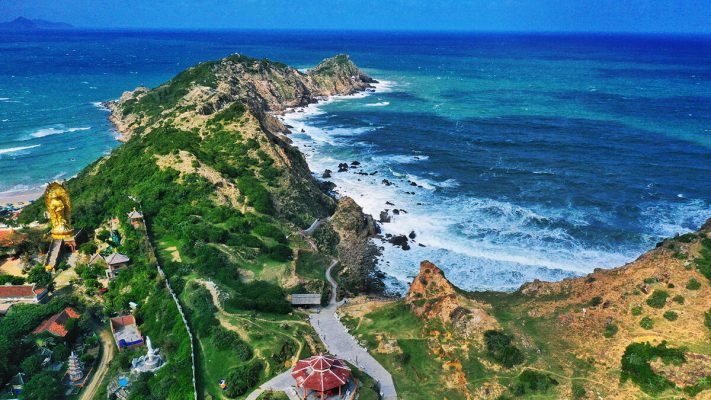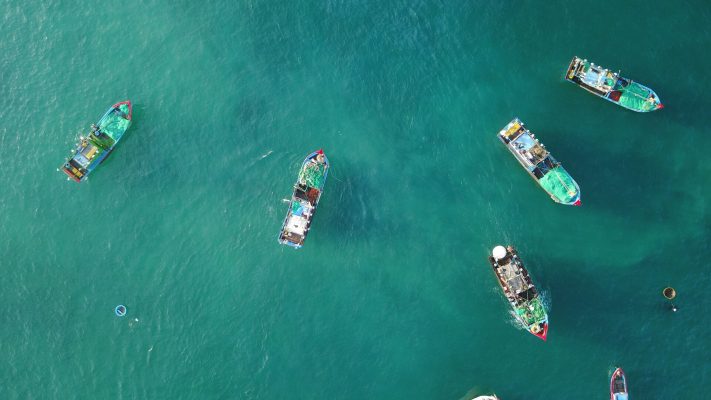Quy Nhon is the cultural, economic, and political center of Binh Dinh, located in the Southeast of the province. Quy Nhon is a quite diverse geographical landscape with mountains, coasts, lakes, peninsulas, and islands, giving Quy Nhon tourism a great advantage in developing and diversifying products. tourism products. With a long coastline, the most beautiful beaches in Binh Dinh are mostly in Quy Nhon City, so referring to Quy Nhon is referring to sea tourism with places such as Eo Gio, Ky Co, and beaches on Quy Nhon. In addition to sea tourism, you can also experience an eco-tourism homestay in Cu Lao Xanh, and participate in water games in Hon Kho.
Table of Contents
General information to Quy Nhon
Quy Nhon was formed very early in the land of Eden in Thuan Quang: over 400 years ago, Quy Nhon appeared. Due to the geographical location, natural and social conditions, and the impact of Western industrial development in the 19th century, Quy Nhon’s appearance has changed a lot. On October 20, 1898, King Thanh Thai issued Chien to establish Quy Nhon town, the capital of the province, which is one of the cities with busy foreign trade now.
Before the tenth century, this place was the land of ancient inhabitants of the famous Sa Huynh and Dong Son culture and then the imperial land of the Champa Kingdom. According to historical changes, in 1471, King Le Thanh Tong established the Hoai Nhon district, comprising three districts: Bong Son, Phu Ly, and Tuy Vien. From then on, this was the meeting place for many periods of Vietnamese immigrants following the Nguyen Lords to expand, explore the land, and settle in the South, in which the land of Quy Nhon city Nowadays, Vietnamese people have also settled down, establishing Chanh Thanh, Cam Thuong, Hung Thanh, Xuan Quang, Quy Hoa,… villages and establishing Vinh Khanh village with a boundary bordering to the foot of Cu Mong mountain. By 1602, 406 years ago, for the first time in history, the place of Quy Nhon appeared when Lord Nguyen Hoang changed the name of Hoai Nhon government to Quy Nhon and considered it as a provincial administrative unit.
This new name has the meaning of wanting to bring together talented and benevolent people. Through 5 times of changing different names, in 1832, King Minh Mang changed the name of Quy Nhon to Binh Dinh province until today. On October 20, 1898, the Hue Imperial Court Secretariat submitted to King Thanh Thai the Instruction to establish Quy Nhon town. Thus, Quy Nhon city today has more than 110 years as the provincial city – the center of politics, economy, culture, science, and technology of Binh Dinh province.
At the beginning of the twentieth century, many new buildings were sprung up such as schools, hospitals, hotels, offices, theaters, bishops, railway transport systems, stations … Therefore, in 3 decades In the first year of the twentieth century, Quy Nhon was quickly urbanized and became a major urban area in the region. On April 30, 1930, the Governor-General of Indochina issued a Decree to upgrade Quy Nhon town to a third-grade city. This was one of the cities in our country at that time that met both administrative and economic culture.
After the war, in February 1976, the two provinces of Binh Dinh and Quang Ngai merged into Nghia Binh, Quy Nhon town became the capital of Nghia Binh province. On June 18, 1986, the Council of Ministers issued a decision to expand and upgrade the town to a provincial city, at that time Quy Nhon city had 8 wards, 7 communes, with an area of 212 km² and a population of 174,076 people. . In 1989, Binh Dinh province was re-established, taking Quy Nhon city as the capital city.
What season should travel Quy Nhon?
Quy Nhon has 2 distinct seasons: the dry season from March to September, and the rainy season from October to February next year. The annual average temperature is about 24.5º C, so it is practically always possible to come to Quy Nhon. However, you should avoid the rainy season in Quy Nhon that usually lasts around the end of the year, with the highest possible storm frequency in September to November. If you plan to come here at this time, you should monitor the weather carefully to avoid affecting your trip.
Guide to Quy Nhon
Being the center of Binh Dinh province, getting to Quy Nhon is quite easy because the entire traffic system goes through here. Highway 1, the section passing Binh Dinh is 118 km long, Highway 1D, the section passing Binh Dinh is 20.7 km long, Highway 19 through Binh Dinh is 69.5 km long. In addition, there are National Highway 19B, National Highway 19C, the system Provincial road (total length of 506 km).
By Public transport
By Road
Located 1,070 km south of Hanoi and 652 km north of Ho Chi Minh City along National Highway 1A, from the two ends of the country, there are many high-quality car routes to Binh Dinh every day. In addition to these direct to local routes, North Bắc South long-haul routes will also pass through this locality.
By Rail
To come to Quy Nhon by railway, you have 2 options for the destination station: Dieu Tri station and Quy Nhon station. Dieu Tri Station is the departure point of the Thong Nhat train lines, the station is about 15km from the city center. Quy Nhon Station is a branch of the North-South railway line, starting from Dieu Tri Station itself. The trains stopping at Quy Nhon station are SQN (Saigon – Quy Nhon), QV (Quy Nhon – Vinh), QN (Quy Nhon – Nha Trang) and DQ (Quy Nhon – Da Nang).
- Every day from Hanoi, there are SE1, SE3, SE5, SE7, SE9 trains departing from Hanoi station to Dieu Tri station. Among the most suitable trains are SE3 (departing at 19:30 and arriving at 17:16), SE5 (departing at 9:42 am and arriving at 6:42 am), SE9 (departing at 14:30 and arriving at 13:44).
- From Saigon, in addition to the train SE2, SE4, SE6, SE8, SE10, SE22 stopping at Dieu Tri station, there is also the SQN2 train stopping at Quy Nhon station; all trains depart from Saigon station. The most suitable trains are SE2 (departing 9:55 and arriving at 8:27) SQN2 (departing at 21:25 and arriving at 10:55), SE4 (departing at 19:45 and arriving at 6:57), and SE8 (departing at 6:55 and arriving at 17:2 ).
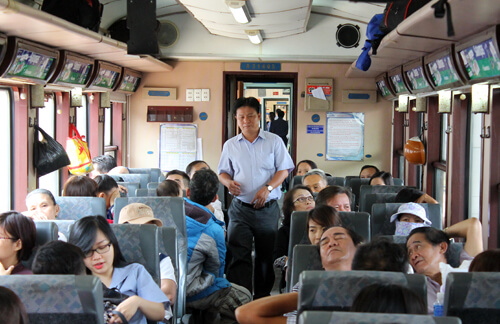
By Airplane
Phu Cat Airport is about 30km away from Quy Nhon City Center. From here, there are daily flights to and from Hanoi and Saigon by all airlines in the country. The fare for the Hanoi – Quy Nhon route in the high season is about 2,000,000 VND and the Saigon – Quy Nhon route is about 1,500,000 VND. Fares vary based on the time of flight, flight time as well as additional services selected by you.
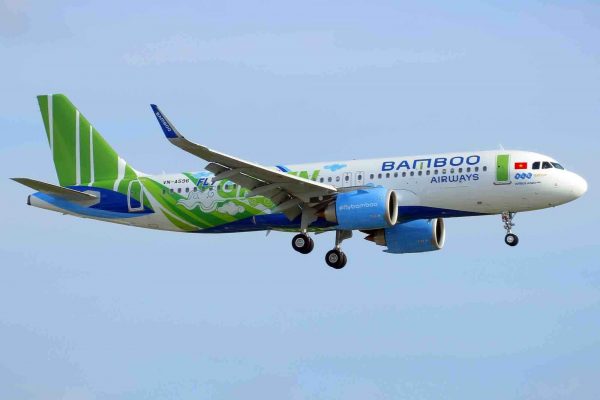
From Phu Cat Airport, there are always bus routes running to the center of Quy Nhon City, these buses operate according to the hours of departure and landing at the airport, so you can completely rest assured to use without fear. Be late.
Going from Phu Cat Airport to Quy Nhon
Phu Cat Airport is about 35km from Quy Nhon city center, right in the airport there is an airport bus to pick up passengers from the airport, drop them off at 1 Nguyen Tat Thanh, the ticket price is 50k. If you go in a large group (> 5 people) you can choose to take a taxi because the package taxi price from the airport to Quy Nhon city is only about 200k, you will be taken straight to the hotel, no extra labor move.
In the opposite direction, if you want to go from Quy Nhon to Phu Cat airport, just go to No. 1 Nguyen Tat Thanh, about 2.5 hours before the flight time, there will be a bus to the airport (bus here takes passengers based on hours actual flight but no fixed time). If you want to take a cheap taxi to the airport, you can also go to this place No. 1 Nguyen Tat Thanh. Here, the taxi driver right outside the gate usually combines about 5-6 passengers to take a trip to the airport which costs about 70k per person.
By Private vehicles
If you have time, you can use a private vehicle such as a motorbike or car to combine visiting Binh Dinh on a trans-Vietnam schedule. From Hanoi, you can go along NH1A or Ho Chi Minh Road through one of the most beautiful coastal spots. From Saigon, you can go around to explore the Central Highlands before transferring the journey to QL1A near the sea.
Traveling in Quy Nhon
By Bus
Currently, Binh Dinh has 11 bus routes to serve the travel needs of people in the province. If you come to Binh Dinh alone and are afraid of traveling by motorbike, you can use this public transport to travel to some tourist destinations.
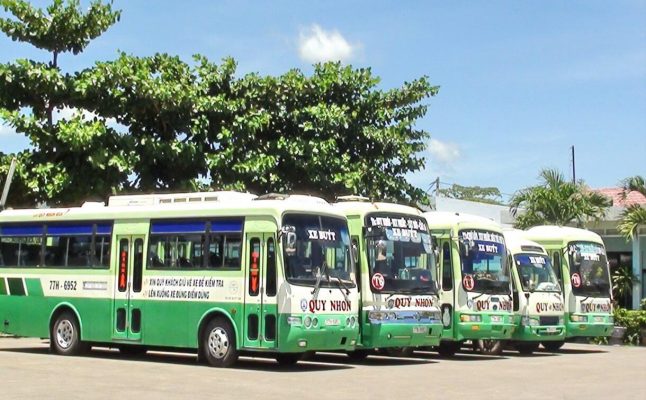
By Tram
Like some other famous tourist destinations, coming to Quy Nhon you can also walk around this coastal city by tram with several stages. Most of these tram lines are currently licensed as pilots to serve tourists who can travel quickly and enjoy the scenery during the journey.
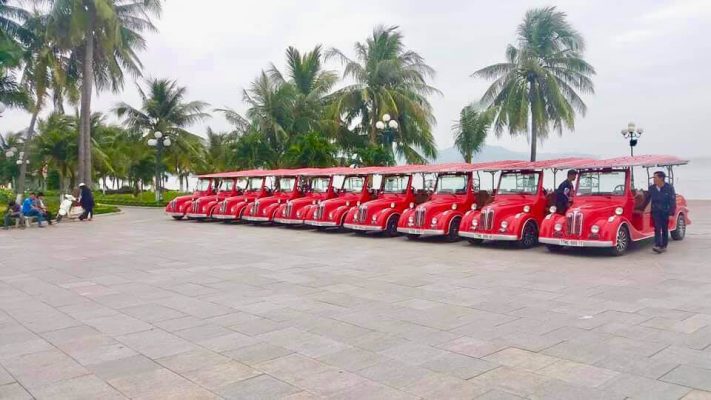
By Taxi
Taxis are the most popular and convenient means for large groups of friends or with families with the elderly and young children because of their mobility, availability, and comfort in all weather conditions. For remote locations, you can contact the full taxi rental according to the price agreed with the driver.
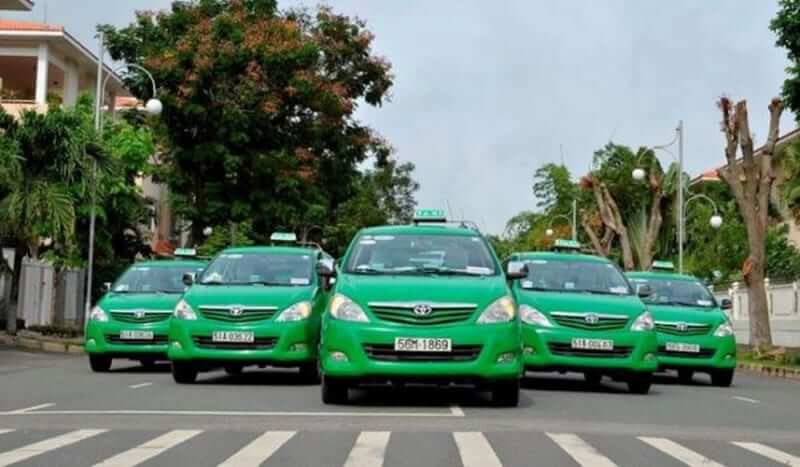
Some taxi companies in Binh Dinh province
- Mai Linh: 0256 3838383
- Huong Tra: 0256 384 7777
- Hoang Anh: 0256 3818965
- Minh Tuan: 0256 3812812
- Thanh Long: 0256 3829292
Rent Motorcycles
If you are in Quy Nhon for a long time and can ride a motorbike on a long road, the most advantageous thing is to rent a motorbike to explore the martial land. A few years ago, the number of motorbike rental shops in Quy Nhon was quite small, so you did not have many options for this service. But with the growth of tourism, and more shops are forming, it is now quite easy for customers to rent a car.
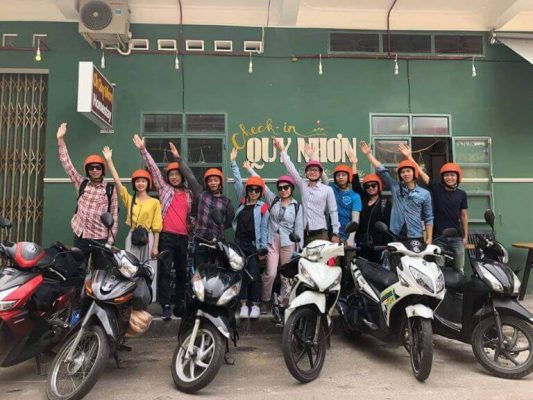
Staying in Quy Nhon
As a rather attractive destination for domestic and foreign tourists in recent years, the accommodation system of Binh Dinh is relatively complete with many types.
Hotel
Currently, in Binh Dinh province, there are more than 200 hotels with more than 5000 rooms, enough to serve a large number of tourists with high-quality resort needs. This number of hotels is mainly concentrated in Quy Nhon City and scattered in several famous tourist destinations.
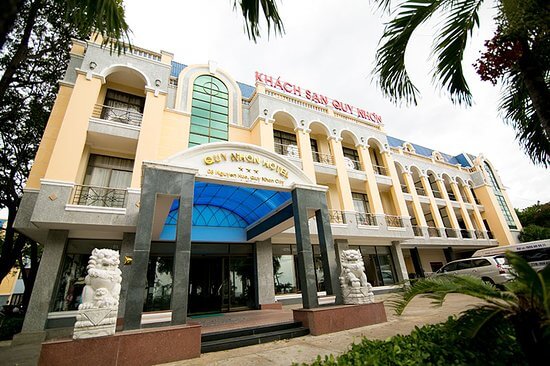
Hostel
The type of accommodation is affordable, cheap, and distributed in many places in the province. For groups of young people who love backpacking, like wandering around to explore many new places, this type of accommodation will be the most suitable because of its reasonable price and ease to find.
Homestay
With topographical advantages to develop ecotourism, Quy Nhon has many strengths to build a type of homestay accommodation to serve tourists. Currently, this type of homestay accommodation is mainly concentrated in Quy Nhon City, Cu Lao Xanh, Eo Gio, Hon Kho,…
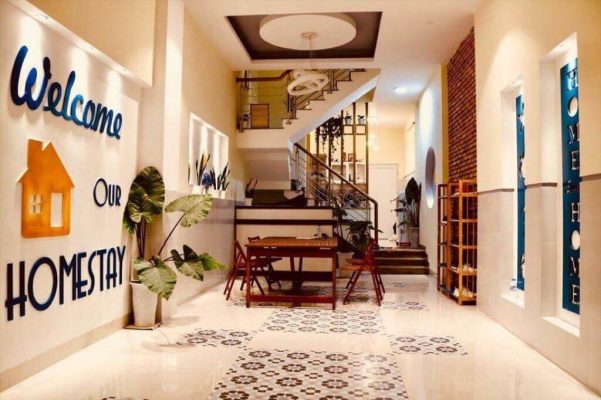
Tourist attractions in Quy Nhon
Quy Nhon Beach
Formed hundreds of years ago, the accretion of nature makes Quy Nhon beach look like a poetic and attractive “crescent moon” and attract tourists. Located right next to the city center, the beach curves with gentle golden sand stretching 5 km from Tan cape to Ghenh Rang, Quy Nhon city.

Ghenh Rang – Tien Sa
Located in the center of Quy Nhon city, the Ghenh Rang tourist area exudes beauty from a wonderful blend of sea and sky on one side and rocky mountains of various shapes. art arranged by nature with a population of sandstone that runs close to the sea, rocks overlap and become very attractive rapids.
Mộ Hàn Mạc Tử
Overcoming the top of Mong Cam slope, turning into the terraced road on the poet hill in the middle of the open poplar forest is the resting place of poet Han Mac Tu. The tomb was built on a high mound, leaning against the mountain, facing the sea. Han Mac Tu is gone, but his poetry will still be in the hearts of poetry lovers. Many generations of poetry lovers have come to him, come to Ghenh Rang to be remembered, and expressed their admiration for a talented poetic soul.
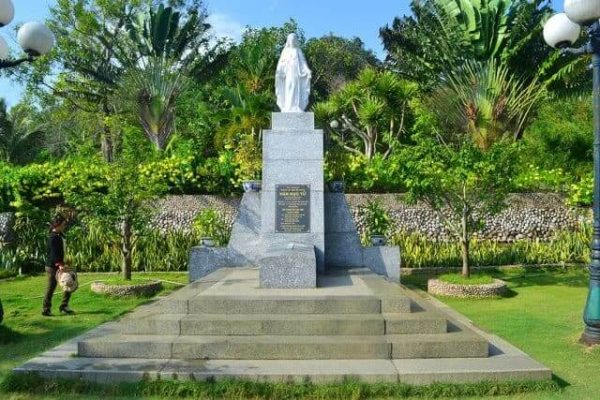
Ghenh Rang Church
Ghenh Rang Church, whose full name is Eucharistic Center, and Thanh Mau Ghenh Rang, belong to Quy Nhon diocese. According to documents, the Stone Church started construction on February 11, 1963, and was inaugurated on August 15, 1964, built by Father Pham Chau Dien. After 40 years of rain and sun, the sea breeze eroded, the church had a degraded and abandoned time. In 2005, the church was reconstructed and inaugurated on February 2, 2007, attracting more and more visitors to visit.
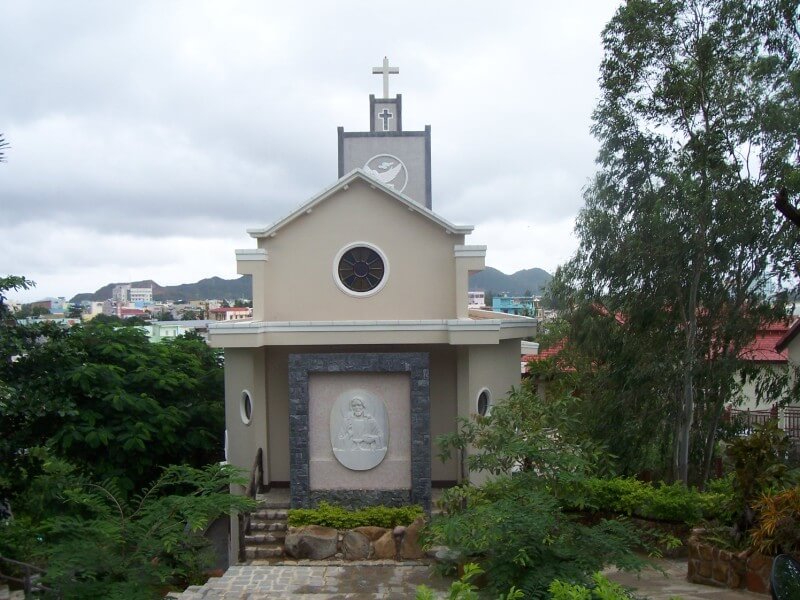
Due to its location on the slope, the entrance to the church is quite winding, but visitors are extremely excited while walking while watching the fresh natural scenery around. Green space with one side is dense cliffs of greenfield vines, ferns, and a long, curving coastline, attracting faster visitors to the campus of Stone Church.
Bãi Trứng
Egg Beach, also known as Hoang Hau beach (the day before each time you visit Quy Nhon, the queen Nam Phuong always comes here to swim) is located in the scenic Ghenh Rang (35 hectares wide), 3 km east of Quy Nhon city. – Male. This beach marks visitors with the beauty of the winding sea road, white sand, blue sea, and countless round rocks on the shore.

In addition to swimming, coming here, you can visit the beauty of Ghenh Rang, the mountains running close to the sea, rocks fluttering into the cave, the city of dawn, visit the tomb of Han Mac Tu poet, learn about Lau Ong Hoang Or down to the island named Hon Dat Bi to explore interesting caves.
Quy Hoa Beach
Quy Hoa beach is nestled next to Quy Hoa wind camp. As the name suggests, Quy Hoa beach is pure and calm with small waves, clear water, and blue rows swaying with the sound of the wind, birds chirping mixed in the sound of waves, creating a feeling of peace and tranquility.
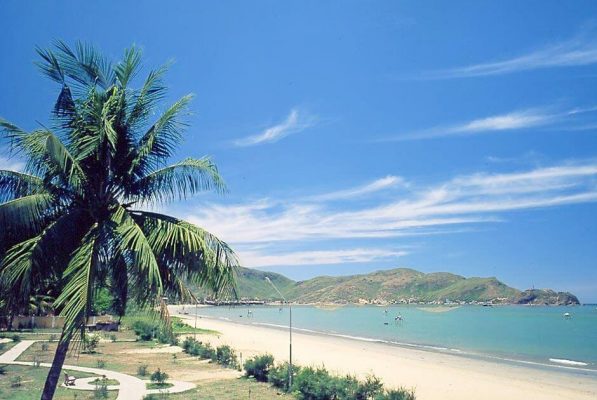
Bai Xep
Bai Xep is 10km from Quy Nhon city along Quy Nhon – Song Cau street and is located in the beach eco-tourism area of Bai Xep exploited by a private company. In addition to the advantage of a beautiful beach, Xep beach is also green with orchards, coconut forests, poplar forests, lawns,… makes you feel like you are in the quiet countryside rather than the whispering waves.
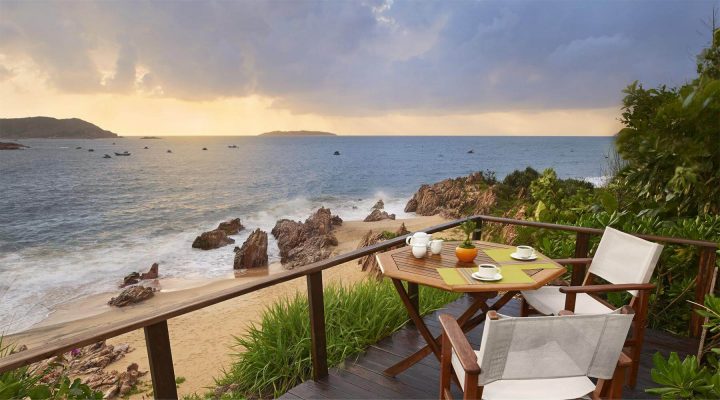
From Xep beach, you can see the beauty of Phuong Mai mountain range, Ngang island, Đat island, and beautiful Quy Nhon bay. Located in the ecological forest of the sea, if you like adventure, you can go back about 1 km to the West, to the Golden Stream, you will encounter a wild natural area with forests, waterfalls …
Bai Dai
The pairing of a clear blue sea line embracing rock formations scattered on the shore and under the sea gives Dai Beach a poetic and angular beauty. The beauty of Dai beach can soften even the most demanding guests.
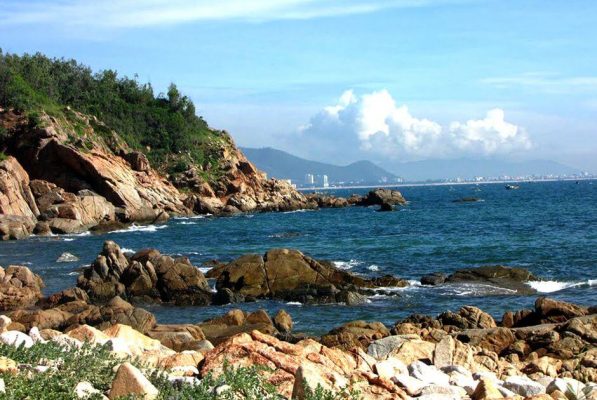
After struggling comfortably in the clear water, you can find yourself shaded among large rocks or swinging in hammocks in the hammocks next to the sea to hear the waves, the wind, the lute resounded from the neighboring huts.
Bai Bang
Surrounded by long bow-shaped mountains stretching out to the sea and offshore islands, Bai Bang beach is clean, beautiful, green, gentle, and is the ideal bathing place. Small houses on stilts, hammocks swinging under the green canopy, rows of coconut trees, fluttering casuarina trees, elaborately trimmed old bonsai pots,… contributed to the poetic features of the area.
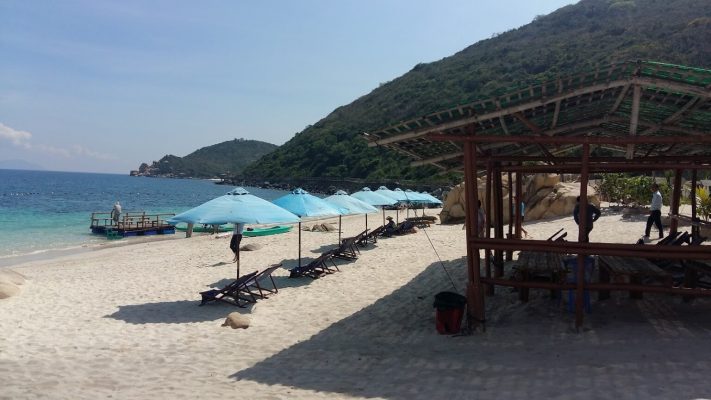
Bai Rang
Is a small beach, located close to Quy Nhon – Song Cau route, in Xuan Hai, Song Cau, Phu Yen. Bai Rang is located between two rocky rapids jutting out of the sea, from National Highway 1D you can see this beach.
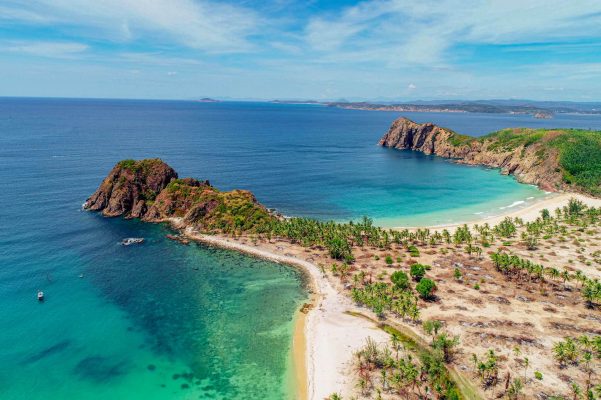
Wind Waist
Eo Gio is located in Hung Luong village, Nhon Ly commune. Hung Luong and Xuong Ly villages, running in the North-South direction.
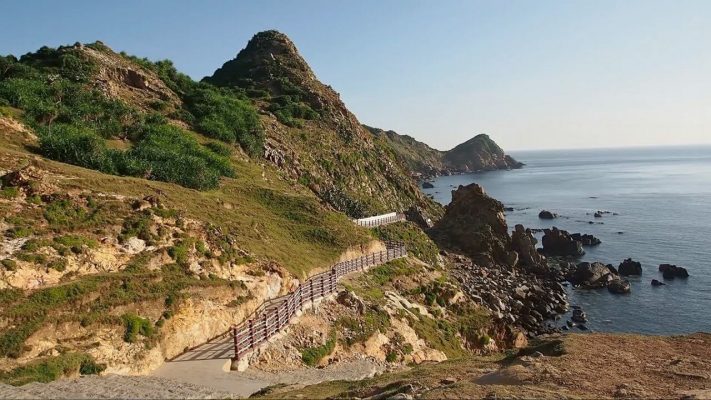
It is called Eo Gio, or Eo Cua Gio because it is hollow like a saddle, located between two high mountains adjacent to the sea. The wind from the sea passed through this valley like pouring into the mouth of the funnel, blowing the cage splendidly, making people sweaty because they wade in the sand, coming here suddenly felt cold.
Ngoc Hoa Vihara
Next to the fishing village at the foot of Eo Gio is a superficial pagoda named Tinh Xa Ngoc Hoa, this is a superficial, quiet pagoda located on the winding bank with the largest two-sided Quan Yin Buddha statue in Vietnam facing the big sea. following the wishes of peace and luck of the friendly fisherman here.
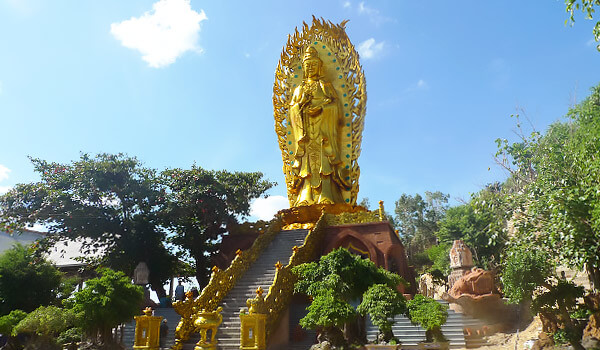
Ky Co
Ky Co in Nhon Ly commune (located on Phuong Mai peninsula) is a small beach with an area of more than 1km², with a shallow, calm beach and extremely unspoiled beauty. This is a place that has not been massively exploited for tourism, but only spontaneous tourism activities from the people to serve the needs of tourists.

Dam Mai Huong
This is a small part of Thi Nai lagoon located along Nhon Hoi Economic Zone and Phuong Mai mountain range, bordering Nhon Hai commune. To reach the lagoon, from Quy Nhon City, drive a motorbike to the intersection of Nhon Hoi – Nhon Ly Economic Zone, turn right to go to Nhon Hai commune, about 20 minutes you will arrive at Mai Huong Lagoon. Standing high above, you will be attracted to the eye between a vast area of water clouds, mixed with plants, flowers, and rocky cliffs along the water’s edge. Far in the middle of the lagoon emerged a stretch of white sand. Heading to the horizon is Thi Nai Bridge stretching out on the sea, creating a picture of tranquil but enchanting nature.

Hòn Khô
Located about 16km from Quy Nhon, Hon Kho Island is like a giant screen covering the fishing village of Nhon Hai. During the rough sea seasons, Hon Kho welcomes the coincidental waves of white foam that look like magic flowers, suddenly appearing, suddenly disappearing. In the quiet sea season, Hon Kho invites visitors with long smooth white sand, colorful coral reefs, velvety green lawns, and freshwater creeks cracked from the cliffs. Coming to Hon Kho, visitors will visit the fishing village of Nhon Hai, snorkel, and enjoy fresh coastal dishes.
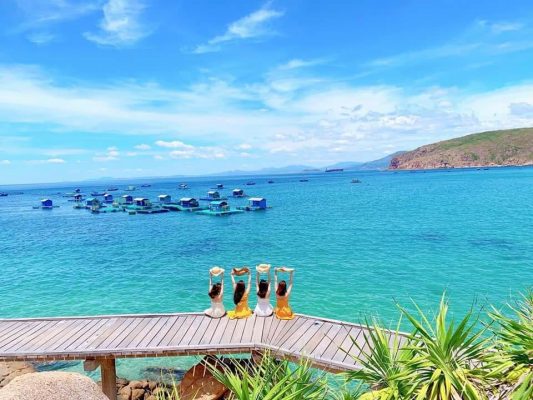
Hai Giang Sea
It is a small oasis located on the Nhon Hai peninsula, a sparsely populated fishing village, but Hai Giang has a unique terrain, located between the mountains and the sea, separated from Quy Nhon city by the mountains of the mountain range. Phuong Mai. To travel here, you can go by boat departing from Ham Tu wharf. Coming to Hai Giang, you can climb mountains, scuba dive, and enjoy fresh seafood dishes right on the island.
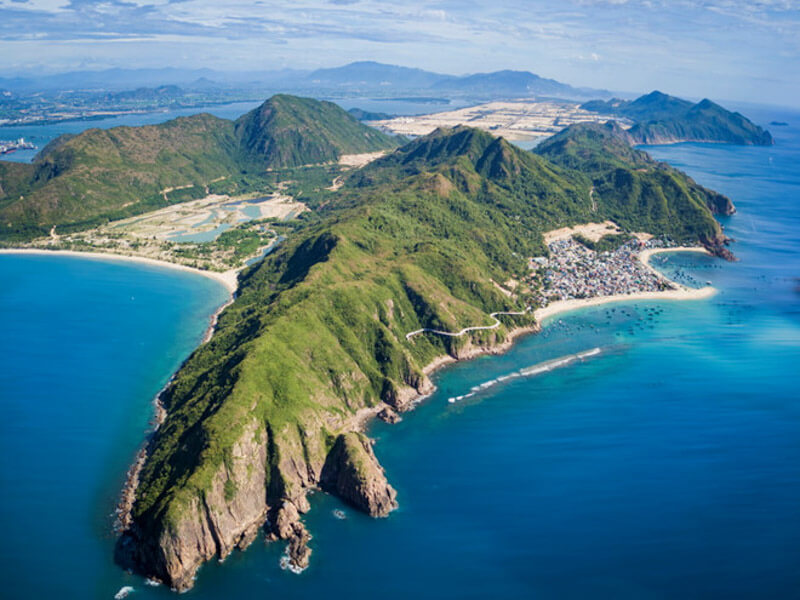
Cù Lao Xanh
Cu Lao Xanh (Nhon Chau Island) also known as Van Phi Island is an island located near Xuan Dai Bay, about 20km from Quy Nhon city center. Previously, Cu Lao Xanh was originally the land of Phu Yen province but was imported to Quy Nhon city after 1975.
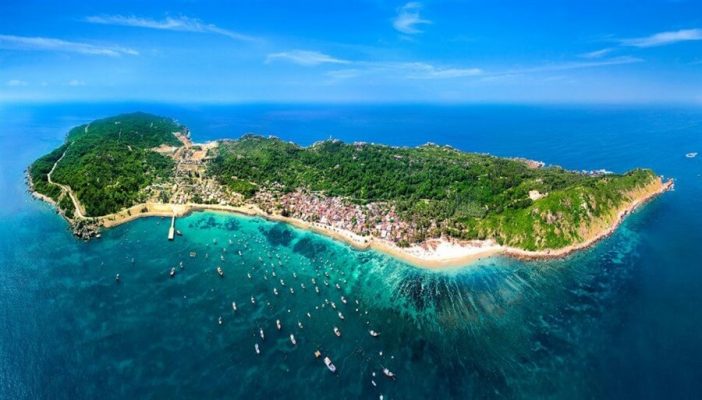
Thi Nai Bridge
Thi Nai Bridge or Nhon Hoi Bridge is the longest cross-sea bridge in Vietnam, located in the system of bridges and roads Nhon Hoi nearly 7 km long connecting Quy Nhon city with Phuong Mai peninsula (Nhon Hoi economic zone), including the main bridge. Crossing Thi Nai lagoon of 2.5 km long, 5 small bridges crossing Ha Thanh river and the road leading 2 bridge ends.
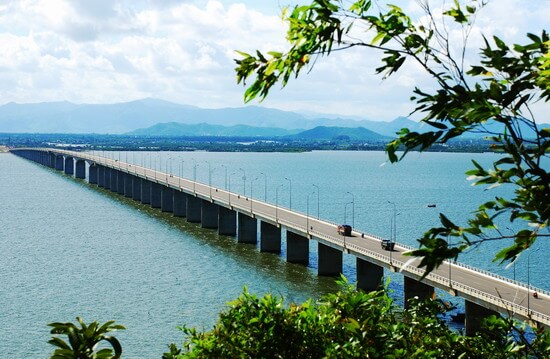
Binh Dinh Museum
Binh Dinh General Museum with an area of 3,673m2 is located in the most beautiful location in Quy Nhon city with 5 booths of over 1,000 documents and exhibits giving viewers an overview and specific view of the countryside. incense of Binh Dinh people through historical periods; Binh Dinh people’s feelings for Uncle Ho and especially the document system and artifacts about the Champa culture.
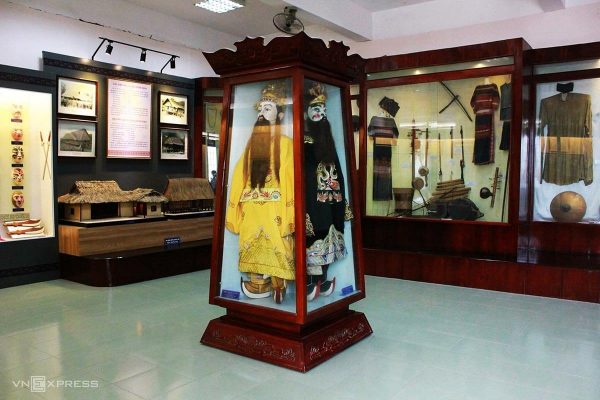
The galleries at the General Museum have 5 compartments with 5 main themes: the “Human country” room with 241 artifacts, the “resistance against the French” room with 122 artifacts, the “resistance against the US” with 233 artifacts, “Cham culture” room, 173 objects, “Uncle Ho’s room with Binh Dinh – Binh Dinh and Uncle Ho” 185 objects.
Twin Towers
Among the remaining Champa towers on Binh Dinh land, there is a fairly unique relic complex located right on the territory of Dong Da ward, Quy Nhon city. That is Hung Thanh tower. The unified Dai Nam chi copied Hung Thanh’s ancient Thap in Hung Thanh village, although the Phuoc district had two customary towers called Thap Doi. In the research works, the French call this Tour Kh’mer because the original view of the architecture and art of this tower has absorbed many influences of the art of this tower, and has absorbed many effects of art Kh’mer technique. In terms of style, the Twin Towers have many similarities with Duong Long tower, all architectural works built around the early decades of the 13th century, when Champa was dominated by Khmer people. The relic is still two not very high towers lying next to each other along the North-South axis. The North Tower is about 16m high, the South Tower is low and a little smaller. Perhaps that is why in folklore it is called by a simple name: The Twin Towers.
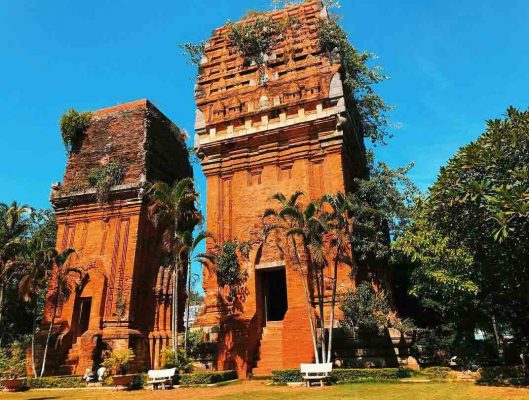
Long Khanh Pagoda
Located at 141 Tran Cao Van, built in the late 18th century. Long Khanh Pagoda was the place to spread Buddhist beliefs in the area at that time. The temple was founded by Venerable Duc Son (Chinese). Currently, the pagoda still preserves two precious objects: Thai Binh Hong (Hong Thai bell) was cast in 1805 in the reign of King Gia Long. The Long Khanh Tu logo plate was printed in 1813 during the reign of King Gia Long.
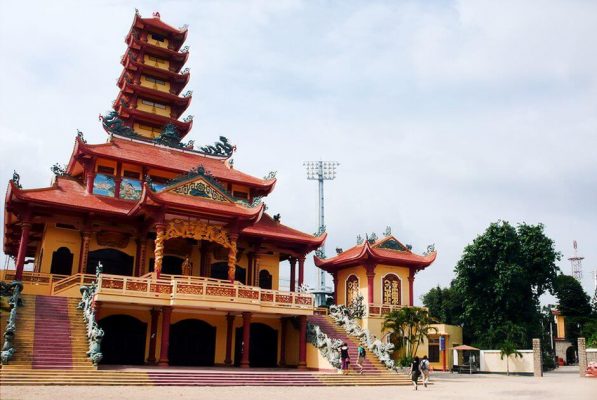
Son Long Pagoda
Son Long pagoda is now in Nhon Binh ward, 700m from Truong Australia bridge to the east. There are many changes in the architecture of the pagoda, but the temple grounds remain the same. The bow-shaped facade is raised, the rocky back face is concave, close to the cliffs. Legend has it that at the foot of the mountain behind the old pagoda there was a very large rock that looked like a dragon mouth with an upper jaw, a small tongue held out in the middle of the lower jaw. That rock is called Ham Long rock, now no longer available. In the pagoda, there are 15 tombs, large and small towers, some graves still retain old mossy features of hundreds of years ago, some towers have been restored more spaciously.
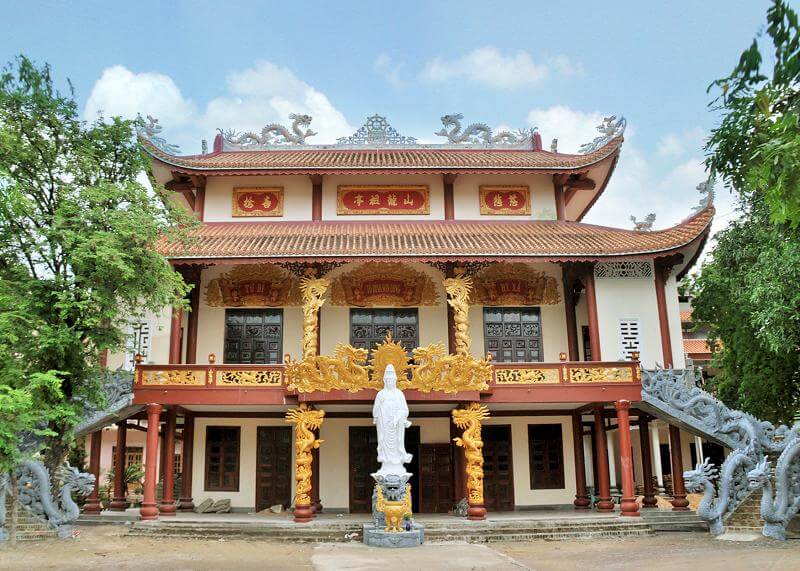
Coming to Son Long, visitors can also admire the 7 dragon-headed convex Buddha statues made of stone weighing 1.5 tons, 3.1 m high with carved patterns behind. Identified statue of the Cham carved from the 13th century. Although its appearance is still modest, Son Long pagoda still keeps tourists from far away to visit, sightseeing,… especially at the beginning of the new year.
Quy Nhon Cathedral
Quy Nhon Cathedral (also known as Our Lady of Heaven and also another name is Nhon Church) is located at 122 Tran Hung Dao Street, Quy Nhon City. The church has a fairly large campus and is planted with many trees,…
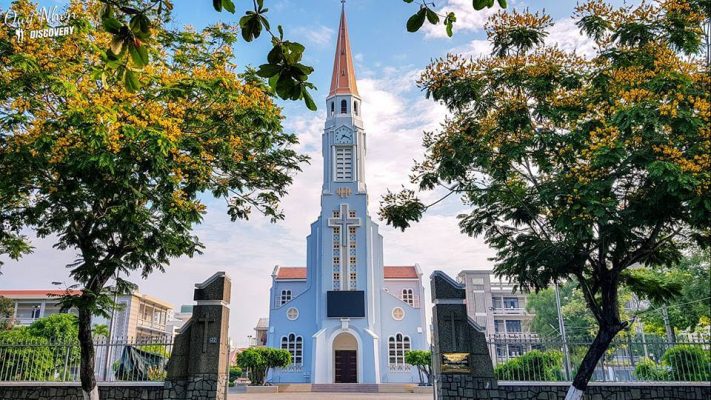
Xuan Van Mountain
Xuan Van mountain is one of the 3 most attractive high points in Quy Nhon. The mountain is 242 m high above sea level. The road to the mountain was built by the Franciscan Missionary Congregation of Quy Hoa (Franciscan Quy Hoa Parish) in the 1950s and 60s of the last century for devotees to pray.
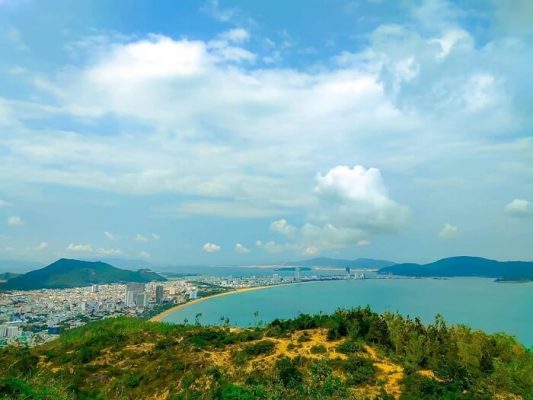
Starting from the Ghenh Rang tourist area, following the mountain slope towards Quy Hoa, about 2 km looking to the right, we will see a small road, paved with cement, which is the foot of Xuan Van mountain. The path up Xuan Van mountain is stone and cement steps, the mountain road is quite narrow, divided into clear stages with 14 numbered stalls with more than 2,000 steps. Easy because of the steps, but the difficulty of Xuan Van is the steep slope, the difference in height of 180 m from the foot to the top of the mountain, the distance between the steps is high. So whoever goes for the first time will feel very tired, especially in the first 3 stages.
On the top of the mountain, there is a fairly wide, flat space with many shade trees. Near the top is the immense sim card flap, around July, August, you should come here to hear the flavor of sim spreading. On the top of Xuan Van, there are many camera angles for you to take free pictures of the panorama of Quy Nhon.
A few other beautiful places in Binh Dinh
System of ancient Cham towers
The Cham towers in Binh Dinh have many top-notch elements of Cham architecture and sculpture. In other localities, the Champa imprint is only ruined, so many Cham towers in Binh Dinh are still almost intact,…
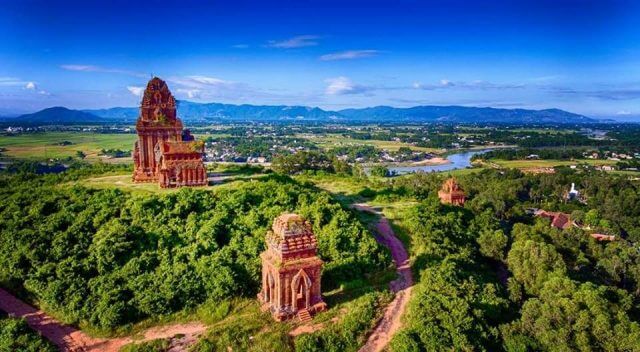
Thien Hung Tu
Thien Hung Tu is built in the area of Nhon Hung ward, the main direction overlooks the rice fields, surrounded by a moat; it is one of the most special and famous temples in Binh Dinh province. Not ancient, not in the location with the best “mountain river” but Thien Hung Pagoda has become a tourist attraction for many visitors when coming to Binh Dinh because it is the place to store the fifth Buddha relics. The Buddhist Church of Myanmar donated it to Vietnam.
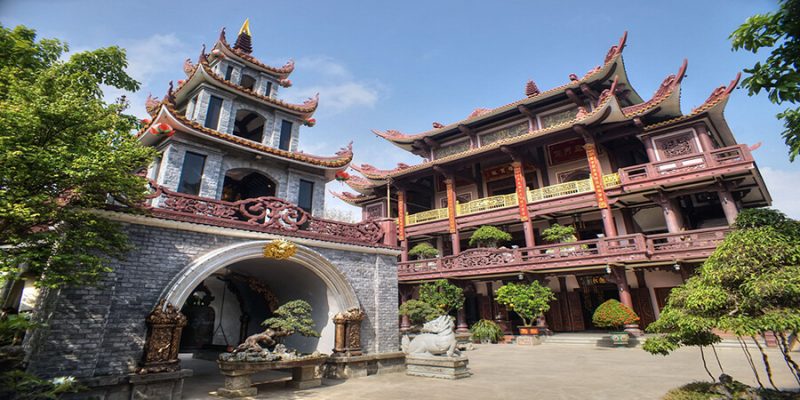
Trung Luong Picnic Area
About 30km from Quy Nhon city, located to the east of DT 639 in Trung Luong village, Cat Tien commune, Phu Cat district (on the Phuong Mai peninsula, not the airport). This is one of the key tourist resorts in Binh Dinh. The sea here is clear and blue as the sky, the color of the mountains, the color of the vastness in the land, there are many mysteries to explore.
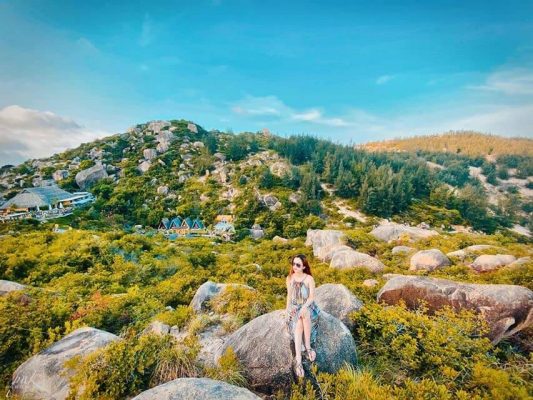
The newest feature of the Trung Luong picnic area is the place to have fun, camping with undulating green and red tents, or rows of colorful chairs with eyes facing the sea. Yellow sunshine, green grass, surrounded by large limestone rocks, and the fresh air blowing in from the land that is already crowded, will make you just want to stop here for hours.
Ong Nui Temple
Binh Dinh people still call Linh Phong pagoda the Ong Nui pagoda (Phuong Phi village, Cat Tien commune). According to documents compiled by the pagoda in 2001, the pagoda was founded by Mr. To Giam Huyen and disciple Tanh Bang (Le Ban) in Giap Ty year (1684) of the 5th Chanh Hoa dynasty under the reign of King Le Hy Tong (according to the book “Dai Nam thống nhất chí ”, the pagoda was established in 1702, the 11th year of Chanh Hoa). Teacher and student “practice meditation in the rock cave. In the front, there is a stream of water pouring down from the top of the mountain, so the cave is named “Dung Tuyen Thach Coc” (strong gushing water cave). After that, Thay Giam Huyen handed over to his disciple Le Ban to go to the South to practice.
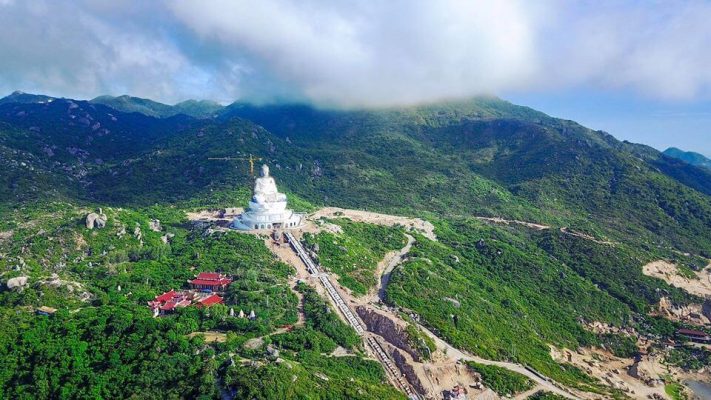
Around 1967, the temple was wiped out by war bombs. Until 1990, the new temple was rebuilt. Upstairs roof, roofed with tiled pipes, on the roof is mounted with a picture of two-dragon paintings, encrusted with porcelain. Double column front electric long roll. The 2.5m high Buddha statue, the common rose weighing 1.2 tons, was newly cast on the spot by artisans from Hue and the reconstruction of the pagoda took place continuously until 2004 to complete as today.
Long Song Minor Seminary
Long River Minor Seminary or Long River Church is an ancient architecture that brings both the spiritual serenity of religious work and the harmony between nature – people and unique architecture that make up a whole most complete.
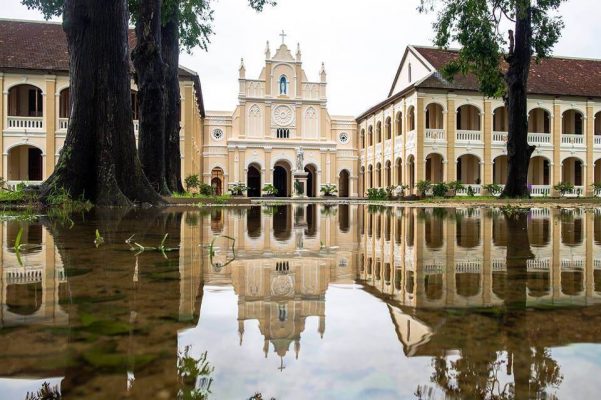
Ham Ho Landscape
It is a stretch of the river nearly 3km long flowing through old forests with large rocks of various shapes in Tay Phu commune, Tay Son district, about 50km northwest of Quy Nhon city. It has a majestic natural landscape with rock formations, shady forests covering the water stream, and enjoying the masterpieces of nature right below the riverbed.
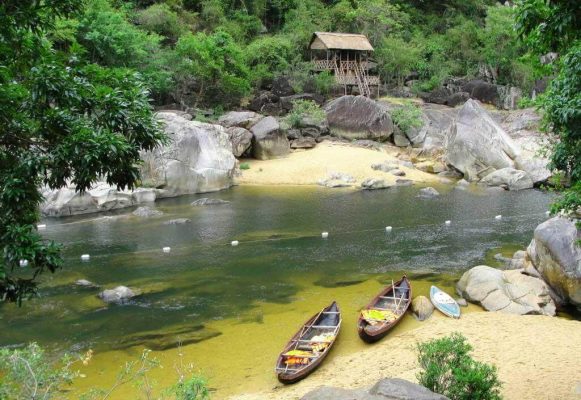
Here you can rent a boat to visit the landscape along the river, this is also the place where the history of the Tay Son uprising as well as the soldiers of Mai Xuan Thuong is engraved.
What to play in Quy Nhon
Seagate Park Tourist Area
Seagate Park is located on the North bank of Thi Nai bridge, 7 km from Quy Nhon city center. This is a park full of wild nature, with a hilly landscape, forest, sea, with many entertainment services designed for all ages. Guests can enter Seagate Park for entertainment, entertainment, and leisure all day. There are many new games for young people, such as artificial climbing at a height of 20m, practicing archery with suitable distances, kayaking, swinging across the lake,… Children playing on ruffled floors, bridges slip off, minibike racing,… Elderly people can walk in an absolute fresh space, with the wind whispering through the immense blue forest, the song of birds singing; and resting and chatting under the ancient shade, beside the beautiful art scene. This is also an ideal place to organize team building activities (collective activities, movement games to help people connect together to perform better tasks,…).
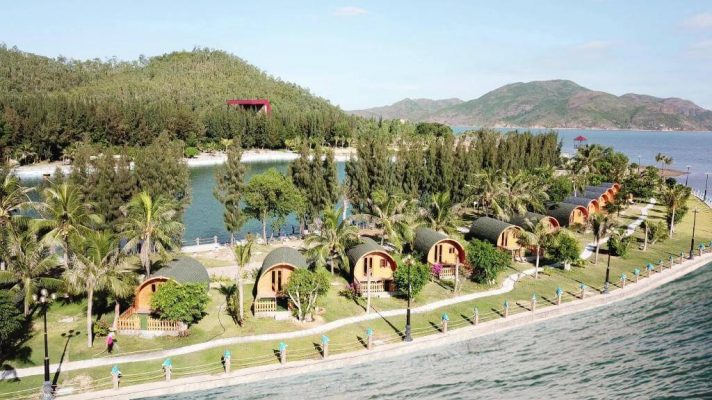
Dive and see coral
You can snorkel and watch the corals in the Hon Kho area or Ky Co. The beaches in these 2 places are green and very clear, just small diving goggles or a dedicated diving suit you can freely watch the coral reefs with shimmering, magical beauty.
Sitting at the seaside cafe
If you are a fan of the beautiful view cafe, you should not miss sitting at the cafe while watching the sea when coming to Quy Nhon. The most famous is the Surf Bar located right on the sand of Quy Nhon beach, followed by S Blue located in the city center square, a little further down is Life’s Beach, a small hotel on the road Quy Nhon – Song Cau.
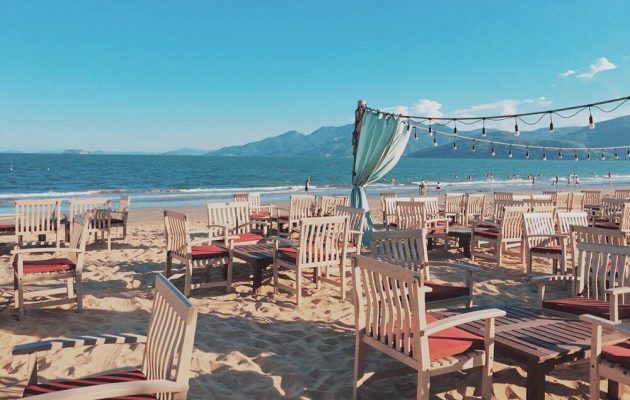
Delicious dishes in Quy Nhon
Banh Xeo Tom Nhay
Interesting right from its name, shrimp pancake dance has long been a famous dish and brings its own flavor of Binh Dinh hometown. The most attractive thing for the first to enjoy this dish is that the cake consists of only shrimp, each cake has about 8-9 round, ripe shrimp mixed with bean sprouts, making the face. extremely attractive and attractive cake. This type of shrimp is small, but the meat is firm and fragrant, and when eaten, it will be strangely sweet.
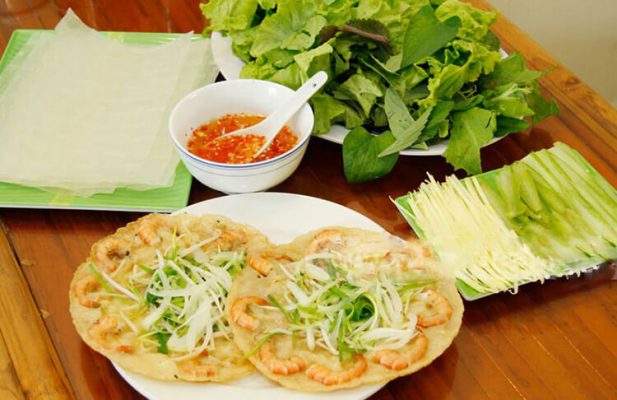
To make the cake delicious, crunchy, people often fry on the burning stove, use a thin layer of fishing fat to spread a thin layer on the pan surface, when the hot old fat layer of the cake is poured in, quickly add the shrimp and sprinkle a few sprouts of bean sprouts, chopped green onions spread on top for more appealing. Only about 3 minutes later, the cake has released a full inviting aroma. Until the underside of the golden cake is crispy, the edges shrink and the bean sprouts turn pale, they can be served hot.
This dish is often served with sprouts to ease boredom. The luscious green vegetables are a little spicy but very cool and nutritious, along with sliced sour mango and some other raw vegetables. When eating, all are rolled in a piece of rice paper with garlic and chili sauce.
Fishball Noodles
This is the most famous specialty in the beautiful coastal city of Quy Nhon. The point that makes the difference compared to fish noodle soup in other localities is fish ball and broth. Fish cakes here are completely processed from fresh fish with many spices that are carefully seasoned according to heirloom methods. The broth is mainly cooked from fish bones, fish heads to create a pleasant sweet taste, unforgettable. Served with fish noodle soup is a typical chili sauce prepared only in Binh Dinh.
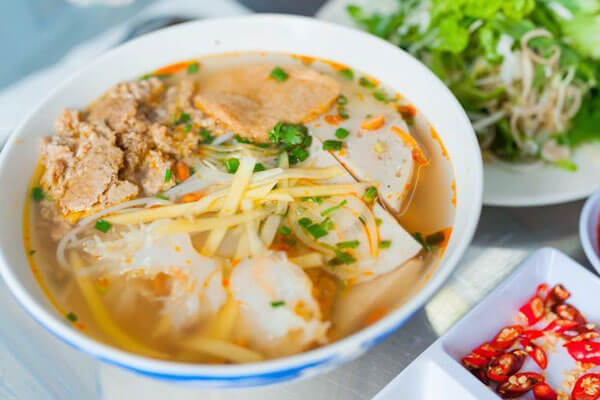
Banh Hoi Long Heo
Banh Hoi originated from Dieu Tri, which is an indispensable dish of the Binh Dinh people every morning. The cake is made from rice-like noodle-making, but the cake is slimmer. Along with the cake are the heart and sliced pork, next to it a cup of hot porridge with garlic and chili sauce mixed slightly sweet to suit the taste of the Central people.
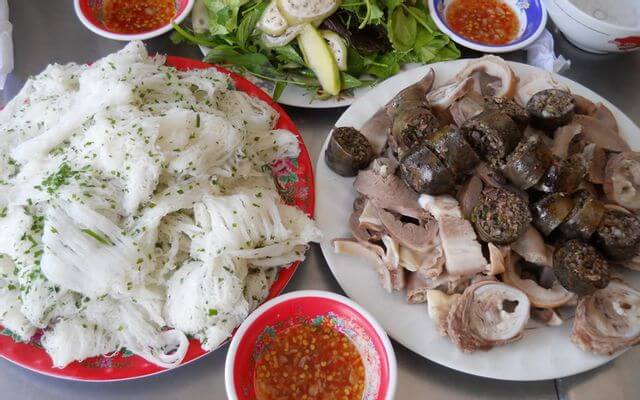
Jellyfish Dishes
If you are a gourmet, when coming to Quy Nhon, you must immediately enjoy jellyfish dishes such as jellyfish vermicelli, jellyfish soup, jellyfish salad,… Jellyfish here is a type of blue-white jellyfish picked from Thi Nai lagoon, cleaned. With jellyfish salad, there must be bananas, green mangoes, coriander, peanuts, coconut fiber, spicy garlic chili sauce mixed. The cool, crunchy jellyfish piece full of sour, spicy, salty, sweet, peanut aroma, fat coconut fiber served with sesame rice paper is only to crave forever.
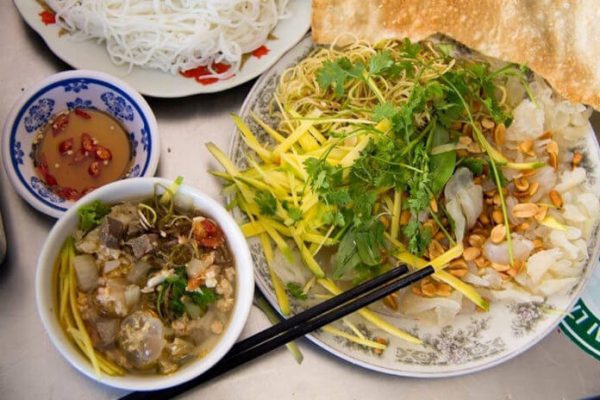
Ga Chi Xoi Chay
From Quy Nhon city, along Highway 1A (Quy Nhon – Song Cau route), if you pay attention, you will see a lot of chicken shops sprouting on both sides of the road. This is the only chicken valley, a not-strange dish but one of the must-try dishes when traveling to Quy Nhon. Called chicken only, simply because when coming to the restaurant, customers will choose the chickens that are already locked in the barn for the shop to process.
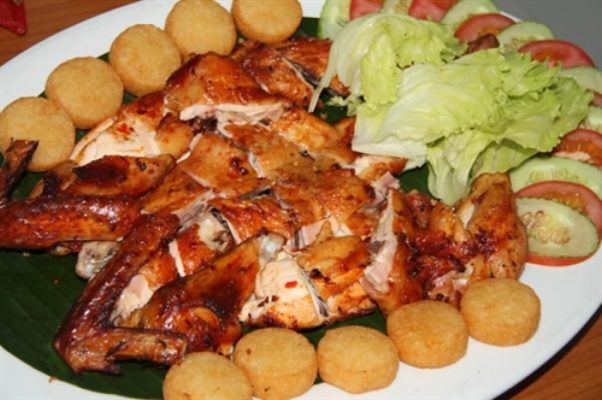
Chicken can be processed in many ways such as grilled, fried with fish sauce, boiled, or steamed, it all depends on the preferences of customers coming to the restaurant. The burned sticky rice is also cooked quite sophisticatedly so that the crust is crispy, but the inside is somewhat loose.
Even in Quy Nhon city (near the Ghenh Rang Tien Sa area), there is a Sau Cao chicken shop that is quite famous and crowded. In addition, if you have time to run along the Quy Nhon Song Cau route, countless chicken shops show you. you choose (Duong Son Quan).
Bún Tôm Châu Trúc
Chau Truc village, facing the shore of Chau Truc lagoon (also known as Tra O lagoon) is one of the largest freshwater lagoons in the province. The people of Chau Truc village live by farming and fishing. It is these two occupations and the soul of Chau Truc people that create an interesting dish, imbued with the soul of the earth, the soul of water, and rustic as the soul of industrious people. That is the Chau Truc shrimp noodle dish. First to mention the stage of making noodles. The rice is soaked in water to soften and then ground. Rice powder water is put into a cloth bag to drain, then put the flour in a mortar to crush. Each powder bowl is an instruction. The vermicelli presses (mold) is made of aluminum tube, one head is empty, one end is sealed, the bottom is tattooed with tiny holes so that when pressed, the vermicelli will run out. The cylinder body is mounted on a press table fixed on a pot of vermicelli broth on the stove. The vermicelli seller presses the vermicelli slowly, running straight into the pot of boiled water. Boiling water, the rice vermicelli stalks turning white to clear white is considered as ripe vermicelli. Using a basket to pick up the vermicelli, passing it slightly in cold water is considered to be finished.

Shrimp used to make vermicelli must be earth shrimp caught from Chau Truc lagoon, still alive, jumping around, put in a mortar, and crushed with a little salt, a little chili,… When someone comes to eat vermicelli, the seller uses chopsticks. Break a chopstick of shrimp meat into a bowl, add some monosodium glutamate, fish sauce, scoop boiling vermicelli into the bowl and stir well, then put the vermicelli in, sprinkle the cilantro stalks, and sprinkle a little pepper. The bowl of noodles is smoky, emits a mild aroma, and has crispy baked rice paper, which is spicy, delicious, sweet, fresh, but rich in flavor.
Bún Rạm Phù Mỹ
It is one of the famous folk dishes of Binh Dinh thanks to the blending of fresh noodles with rich, rich flavored water. The flesh is smaller than a crab with a hard shell, flat body, lots of bricks, and sweet and fatty meat. To make this dish, you must choose the type in Tra O lagoon to have a different sweet and fragrant flavor. Often gourmets will choose female flakes because of the soft shell, the more bricks, the bigger, the meat is firm. The soil is soaked to clean the soil, then washed, pureed, filtered like a crab, seasoned with spices, then brought to a boil over a simmering heat. Chopped dried onions are non-aromatic with fat or cooking oil and then poured into the broth to make it aromatic. When boiling, the broth will match and float the scum of meat and fat, which thickens the entire pot of water.

Quy Nhon Travel Schedule
Quy Nhon and Binh Dinh have many entertainment spots, but these places are usually quite far from the center of Quy Nhon city, so if you do not have children with you, you will actively rent a motorbike to travel for your children. Let’s share with you a few neatly packed daily schedules as follows (depending on the time you stay, you can actively cut down any day to suit you)
Tour 1: Quy Nhon – Song Cau – Tay Son
Day 1: Quy Nhon – Eo Gio – Ky Co – Nhon Hai
- From Quy Nhon city, go in the direction of Tran Hung Dao and turn over Thi Nai Bridge, the longest cross-sea bridge in Vietnam.
- On the side of the bridge, turn left in the direction of Nhon Ly. Come here to Eo Gio to take pictures, next to the Ngoc Hoa Monastery with the statue of a two-sided bodhisattva.
- Buy a tour to Ky Co, swim, and have lunch there
- At the beginning of the afternoon, the train will take you back to Nhon Ly
- From Nhon Ly, back to the direction of Thi Nai bridge, follow the sea to Nhon Hai to play Hon Kho. On the road from the bridge to Nhon Hai, you will pass through Phuong Mai lagoon, the scenery is quite beautiful.
- In Nhon Hai, there are also cruise ships waiting to take you out to Hon Kho, continue swimming, and dive to watch the coral. Afternoon stays to welcome sunset and dinner right here.
- Late at night, back from Nhon Hai to Quy Nhon city to rest.
- In the evening, you can go to the beach and sit at Bar Surf, enjoy the sea breeze and listen to music.
Day 2: Explore Quy Nhon City, running along Quy Nhon – Song Cau route
- Get up early in the morning to have breakfast, enjoy the familiar food of the people here: Banh asks for Porridge Heart, make a few cups of coffee.
- You should take a little time to visit the Binh Dinh Museum, which is also in the city. It takes about 30 minutes to briefly understand the culture and people of the martial arts land here. Admission is completely free.
- Running along Xuan Dieu coastal road, turning in the direction of Quy Nhon University, you will reach the Ghenh Rang tourist area, Tien Sa. Here you can go to the Egg Stone Beach (Queen Beach), the tomb, and the Han Mac Tu memorial area …
- Continue following the Quy Nhon – Song Cau route, you will go through all the beautiful beaches of Binh Dinh such as Quy Hoa beach, Xep beach, Nhom beach … and the last point is Song Cau town.
- This day is mainly wandering, so you just prepare a few snacks, drink water, and then jump down to the beach.
- In the afternoon, we returned to Duong Son Quan to enjoy chicken and fried sticky rice, a dish recommended by many people.
Day 3: Quy Nhon – Tuy Phuoc – An Nhon – Tay Son
- On this 2nd day, you will go in a circle. Around 8:00 am, the starting departure is just because the schedule is quite long.
- From Quy Nhon city, continue to follow Tran Hung Dao street, stop at Thap Doi to find out a bit, and then continue to follow this road.
- Go straight to Nguyen Hue Street of Tuy Phuoc Town to the intersection of Ba Di Bridge, look on the right-hand side you will see Banh Be Tower, turn in, and spend about 30 minutes exploring.
- Continue towards An Nhon Tx, you go to Ngo Duc De Street and go straight to 636B, on the way you will pass Bau Da wine village
- Continue to follow the map to Duong Long Tower.
- Leave Duong Long tower to go to the center of Tay Son district, stop by Quang Trung museum
- From here, it is about 8km to reach the Ham Ho tourist area, if it is still early, you can take advantage of exploring, otherwise you can skip it.
- Tay Son comes back to Quy Nhon city about 40km, you follow Highway 19 to be able to return, no need to return to the old road.
Tour 2: Discover Cu Lao Xanh 2 days
Day 1:
- Train to Cu Lao Xanh (Nhon Chau) departs at 8 am so you remember to be early at Ham Tu port. Around 9:30 the train arrives at Cu Lao Xanh, you store your luggage at the pre-booked location
- Go swimming, snorkeling, and watching coral. Lunch
- Afternoon continue to explore other locations on the island such as Lighthouse, Fatherland flagpole
- If you are traveling in a tent, you can find a place for a BBQ
Day 2: Get up early in the morning to watch the sunrise and then go around the bridge area to see the fish harvest. Have breakfast, then board the train back to Quy Nhon.
Related Article: Traveling experience in Ban Gioc Waterfall that tourist should know
Let start your trip to Quy Nhon with us! If you have any feedback or need help, please send an email through vietnamreviewer.contact@gmail.com!

